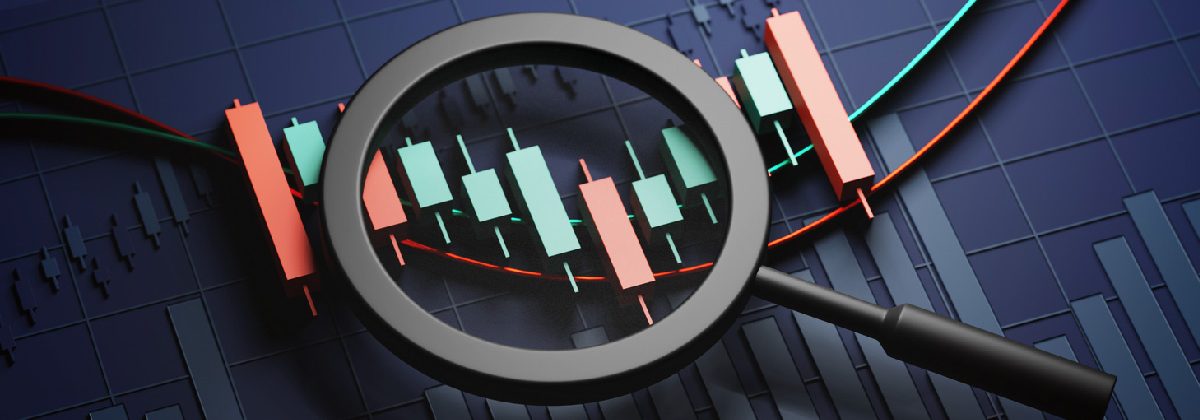How to Identify Tops and Bottoms on Candlestick Charts?

Candlestick chart tops and bottoms are an essential part of strategies for trading trend reversals. However, there are certain nuances to all candlestick charts, learning which can help improve the accuracy of technical analysis and prevent false positives. Here’s what you need to know to trade trend reversals using tops and bottoms.
What are Tops and Bottoms?
Tops arise in an uptrend, when the market is ready for a reversal. Tops are popularly used to exit long positions or enter short ones.
Bottoms occur during a downtrend. Bottom candlestick chart patterns precede a bullish reversal. Traders use them as signals to take long positions or exit short ones.
Trend Reversal Candlestick Patterns
Identifying a trend reversal requires careful attention to the sizes of candlesticks, and the open, close, high and low points for the candlestick duration. Here’s what you need to know about popular candlestick reversal patterns.
Tweezer Tops and Bottoms
A tweezer pattern arises when two different candles (a bearish and a bullish one) occur consecutively with similar highs (in an uptrend) or similar lows (in a downtrend). The two-candlestick pattern makes paying attention to details a little challenging. However, learning to read them is important to grab trading opportunities in time.
Image Source: Elemental Markets
Tweezer Top
A Tweezer top is a bearish pattern that signals the reversal of an uptrend.
- The pattern begins with a long bullish candlestick with small top and bottom wicks.
- The second candlestick is bearish with a top the same as that of the first one, a smaller length, and a long bottom wick.
The top here is the resistance level, and the pattern is confirmed, with the following bearish candlesticks with the price making lower lows.
Tweezer Bottom
The tweezer bottom is the opposite of the tweezer top. It appears in a downtrend indicating a bullish reversal.
- The first candlestick is bearish, with a long body and tiny wicks.
- The following green candle has a similar bottom (the support level), a lower top and a long upper wick.
The following green candlesticks with higher lows and highs confirm the uptrend.
Double Tops and Double Bottoms Pattern
Double tops and double bottoms are multi-candlestick chart patterns. These patterns take shape in about 15 or more timeframes.
Double Tops
Image Source: Elemental Markets
Double Tops, also known as “M,” is a bearish reversal pattern. It is formed when an uptrend has reached its limit and momentum starts to fade. The key to identifying the pattern is observing the lengths of the green, candlesticks with a closing price higher than the opening price, and that of the red ones, i.e., those with a closing price lower than the opening price candlestick.
- As the candlesticks form an M, the length of green candlesticks starts to decrease, while the length of red ones gradually increases.
- Both the peaks of the M pattern will have green (or blue) candlesticks with similar closing prices.
- The bottom of the double tops pattern roughly coincides with the support level for the price range of the two peaks and the valley between them.
A double-tops pattern begins when the price trending upwards and bounces off the resistance. It reverses once, bouncing off the support. Once again, the price bounces off the resistance level, and this time breaks down from the support marking the onset of the downtrend. Using the RSI indicator or other oscillators to mark the resistance and support can aid in identifying the double tops reversal candlestick chart.
Double Bottoms
Image Source: Elemental Markets
A double bottom occurs when a downtrend is about to reverse. It is also called a “W” candlestick pattern. Here’s how to identify it:
- Use an oscillator, such as the stochastic oscillator, or a dynamic one, such as Fibonacci, to identify the current support and resistance levels.
- When the down-trending price bounces off the support, start noting the formation of the first valley.
- The price should bounce off the resistance to form a peak. You will also observe that the length of red candlesticks is either decreasing or remains similar, while that of the green ones increases after the second valley.
- The downward price then bounces off the support again and breaches the resistance with strong momentum. This marks the onset of the uptrend. You may also observe a price gap around the time the uptrend is about to begin.
The “W” pattern is complete. You can take positions according to your trend-reversal trading strategy.
Head and Shoulders
Head and shoulders are also a pair of multi-candlestick chart patterns for trend reversals.
Bearish Head and Shoulders
Image Source: Babypips
After a sustained uptrend, the price forms a bearish head and shoulders pattern, with the lower trendline serving as the neck.
- The pattern begins with a peak, after which the price begins to decline. This forms the left shoulder.
- The price reaches the lower trendline (the neck) and bounces off, making a noticeably higher high than the first peak. This second peak is the head.
- The price declines back to the neck and bounces off again to make a peak similar in height to that of the left shoulder. This is the right shoulder.
- After the head and shoulder pattern is completed, the price breaches the lower trendline, breaking into a downtrend. This confirms the trend reversal.
Note that the neck is the support level here, and the peaks of the left and right shoulders indicate the resistance. The price only momentarily breaks the resistance when bulls try to overpower bears and sustain the trend for longer.
Image Source: Babypips
Bullish Head and Shoulders is the opposite of the bearish head and shoulders, where the top trendline serves as the neck.
To Sum Up
- Tops and Bottoms are popular trend-reversal candlestick chart patterns.
- Observe the size, colour and wick-length of the candlesticks to avoid false positives.
- Head and shoulders, double tops and bottoms, and tweezers are some of the popular patterns that use candlestick tops and bottoms.
- Use supporting indicators to confirm candlestick chart signals to make informed decisions.
Disclaimer:
All data, information and materials are published and provided “as is” solely for informational purposes only, and is not intended nor should be considered, in any way, as investment advice, recommendations, and/or suggestions for performing any actions with financial instruments. The information and opinions presented do not take into account any particular individual’s investment objectives, financial situation or needs, and hence does not constitute as an advice or a recommendation with respect to any investment product. All investors should seek advice from certified financial advisors based on their unique situation before making any investment decisions in accordance to their personal risk appetite. Blackwell Global endeavours to ensure that the information provided is complete and correct, but make no representation as to the actuality, accuracy or completeness of the information. Information, data and opinions may change without notice and Blackwell Global is not obliged to update on the changes. The opinions and views expressed are solely those of the authors and analysts and do not necessarily represent that of Blackwell Global or its management, shareholders, and affiliates. Any projections or views of the market provided may not prove to be accurate. Past performance is not necessarily an indicative of future performance. Blackwell Global assumes no liability for any loss arising directly or indirectly from use of or reliance on such information here in contained. Reproduction of this information, in whole or in part, is not permitted.




